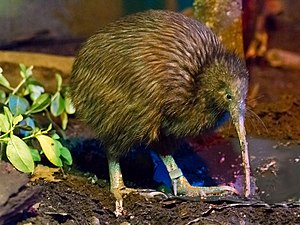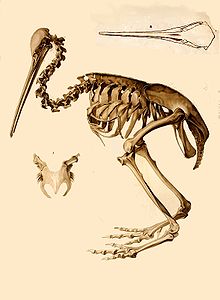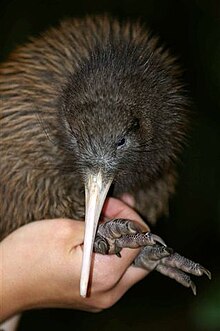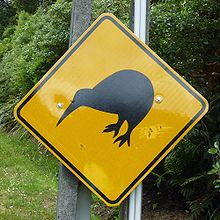Kiwi fruit
| Kiwi fruit | ||||||||||
|---|---|---|---|---|---|---|---|---|---|---|

Northern striped kiwi ( Apteryx mantelli ) |
||||||||||
| Systematics | ||||||||||
|
||||||||||
| Scientific name of the order | ||||||||||
| Apterygiformes | ||||||||||
| Haeckel , 1866 | ||||||||||
| Scientific name of the family | ||||||||||
| Apterygidae | ||||||||||
| Gray , 1840 | ||||||||||
| Scientific name of the genus | ||||||||||
| Apteryx | ||||||||||
| Shaw , 1813 | ||||||||||
| species | ||||||||||
|
Kiwis (genus Apteryx ) or ostriches are flightless, nocturnal birds in the forests of New Zealand . The genus is the only one in the Apterygidae family and currently consists of only three or five species, depending on the doctrinal opinion . Among the ratites , kiwis are by far the smallest representatives.
The kiwi is the national symbol of New Zealand. It is from him that the residents of New Zealand call themselves “Kiwis”.
features
Kiwis are not only the smallest of all ratites, but their biology is very different from that of the other ratite families. They are 35 to 65 centimeters long, up to 35 centimeters tall and one to five kilograms in weight. Females are, on average, slightly larger and 10 to 20 percent heavier.
They have brown plumage that almost looks like hair. Like all ratites, the kiwifruit lacks the sternum ridge , to which the flight muscles normally attach. The kiwis still have small, four to five centimeters long wings , but are not able to fly with them. The wings have small claws at the ends and remain hidden under the plumage. The claws have no recognizable function and are apparently rudiments that can be found on some emus and cassowaries alike .
Kiwis do not have an externally visible tail , which contributes to their unusual oval body shape. The legs, which are pushed far back, also contribute to this appearance. Like most birds, these strong legs have four toes ; with them, kiwis can run well and quickly. However, longer escape distances are usually unnecessary in their confusing living space . The head of the kiwifruit is relatively small, the beak very long and curved downwards. The beak of the striped kiwi is over 20 centimeters long. In females it is a good 30 percent larger than in males. The upper beak is slightly longer than the lower beak. To keep their balance while standing , kiwis often lean on their beak. Kiwis cannot see very well , but they can hear all the better and - a specialty among birds - smell very good . The nostrils are at the tip and not, as in most birds, at the base of the beak. At the beak base wear Kiwis "bristles" that the vibrissae remember (whiskers) of mammals, but in reality modified springs are.
Another special feature is the body temperature , which at 38 ° C is far below that of most birds (42 ° C) and is more like that of a mammal.
voice
Because of their nocturnal and hidden way of life, the vocalizations are often the only thing people notice from kiwis. Kiwis call all year round, all night long, except in strong winds and on very bright full moon nights.
The calls are shrill whistles that carry you up to five kilometers under favorable conditions. As kiwis expel these, they stretch their necks and bills up. Males call more often than females, and their whistles sound different in pitch and length.
The calls seem to play a role mainly in the area defense. They are often answered by kiwis from the neighboring districts.
distribution and habitat

Kiwis live on the three large islands of New Zealand: North Island , South Island and Stewart Island . They are also found on numerous small islands off the coast of New Zealand; on most of them, however, they have been introduced with certainty, on the others with a high degree of probability by man.
The original habitat of the kiwis were the forests, which, with the exception of the high mountains, covered New Zealand almost completely before the arrival of Polynesian settlers. Today they are also at home in the artificially created, bushy open areas. They are also one of the very few indigenous animals that have been able to settle in the conifer monocultures planted by the Europeans . However, despite their adaptability due to the pressure of hunting from imported predators, kiwis have disappeared from numerous regions and are only sparsely distributed across New Zealand.
In the mountains there are kiwis up to an altitude of 1200 meters. All kiwis need habitats with high levels of moisture and loose, humus-rich soil.
Way of life
activity
Kiwis are only active at night. During the day they hide in their caves and shelters, which they do not leave before sunset. When they come out, they move in total darkness under the protection of undergrowth and bushes. In doing so, they orientate themselves, which is rather unusual for birds, with their good sense of smell and hearing.
All their lives, the Kiwis inhabit a territory that they share with the partner with whom they live in monogamy . The area is defended by both sexes and has a size that varies greatly from species to species: dwarf kiwis guard only 2 to 3 hectares , while the area of a striped kiwi pair covers 5 to 50 hectares. While the territory boundaries are aggressively defended during the breeding season, the presence of other kiwis in the territory is tolerated to a certain extent at other times of the year. If a territory is lost through clearing , a kiwi couple often stays there for several weeks before looking for a new environment. The territorial boundaries are marked with excrement, again a behavior that is actually typical of mammals and that is otherwise almost impossible to find among birds.
Within the area, kiwis build numerous burrows that are used alternately. They are used for sleeping and also as a breeding cave during the breeding season . The entrance is up to 15 centimeters wide and mostly hidden under dense vegetation or between tree roots. A tunnel up to two meters long leads from here to the cave, which is large enough to offer space for two kiwis.
Solitary kiwis are either young birds or those that have lost their mate.
nutrition
Although kiwis are omnivores that feed on all animal and vegetable materials, they mainly poke the ground for invertebrates, especially earthworms , millipedes and insect larvae. The movements of the animals in the ground can be perceived by kiwis; they then sink their beak into the ground and feel the prey. As a result, kiwis leave characteristic beak holes in their territory, which are up to 15 cm deep and reliably reveal the presence of a kiwi.
In addition, fruits and insects are picked up from the ground.
Reproduction

As monogamous birds, kiwis don't look for a new partner until the old one has died. Kiwi couples have been observed to have been together for over ten years. Every year between August and October the breeding season begins for the kiwi pairs. They then chase each other, make jumps and are extremely happy to call.
Only one of the burrows in the area is used for breeding, and always one that is several months or even years old, so that the entrance could be overgrown with vegetation. The male prepares the nest by collecting mosses and grasses and using them to pad the nest cavity.
The female then lays one or two, rarely three eggs. With the striped kiwi, the egg is 13 cm long and has a diameter of 8 cm. The weight is about 500 grams. In relation to the height of their producers, these are the largest bird eggs in the world - they can reach up to 30 percent of the body weight of the female. With the striped kiwi and the dwarf kiwi, only the male incubates afterwards, with the Haastkiwi both sexes alternately. If the male breeds alone, the female sleeps in another burrow that is nearby. The breeding season is unusually long at 63 to 92 days. The brooding male leaves the burrow every night to feed; the duration of the activity is hardly restricted during the brood. With the Haastkiwi, the female takes over the breeding business during these breaks. The eggs are very endangered, especially Wekarallen are after kiwi eggs.
The hatching kiwis already look like the parents' small editions. When they flee from the nest, they wander around five or six days after hatching. While they are guarded by the male during the day, they leave the nest alone at night and are hardly guarded by their parents. The young are therefore very often the victims of the cats, dogs and weasels introduced into New Zealand.
At one and a half years of age, kiwis reach their full size and at two years of age they are sexually mature. They can live to be over 20 years old.
Systematics
External system
The classic view of the external system is that the closest relatives of the kiwis should be the moas . This view was justified only by the fact that these two ratite families are common in New Zealand. However, it is likely that they separated a long time ago when New Zealand was still part of Gondwana , and that it is more of a coincidence that both taxa only survived in New Zealand until the Holocene.
New DNA analyzes come to the conclusion that kiwis are not related to moas. Both Haddrath & Baker 2001 and Cooper 1997 concluded that the kiwis are the sister group of a common taxon of cassowaries and emus , and that these three taxa together are in turn the sister group of ostriches . However, this thesis is not undisputed either. In mid-2014, after comparing mitochondrial DNA, Mitchell and colleagues identified the giant, extinct Malagasy elephant birds (Aepyornithidae) as a sister group of the kiwifruit. Both are said to descend from ancestors capable of flying and to have separated evolutionarily from each other about 50 million years ago. Since the moas already existed in New Zealand and the ecological niche of the large ratite was already occupied, the kiwis developed into nocturnal small animal-eaters.
Internal system
Five species in one genus are counted among the kiwifruit:
- Zwergkiwi or Kleiner Fleckenkiwi ( Apteryx owenii )
- Haastkiwi or Great Fleckenkiwi ( Apteryx haastii )
- Northern striped kiwi ( Apteryx mantelli )
- Rowi or Okarito-Striped Kiwi ( Apteryx rowi )
- Tokoeka or Southern Striped Kiwi ( Apteryx australis )
The three striped kiwi species are often considered to be subspecies of one species, the striped kiwi. The classification shown above follows the view of Burbidge 2003, according to which these subspecies should receive the status of independent species.
Fossil history
Kiwi fossils are only known from the Pleistocene and Holocene . However, presumptions that they are a very ancient group of animals are supported by footprints from the Miocene that are assigned to the kiwis. An occasionally mentioned fossil species from the Pliocene of Australia ( Metapteryx bifrons ) is, according to most zoologists, in fact a young animal from the family of the emus .
People and kiwis
Since the first Māori settlers reached New Zealand, kiwis have been hunted on a large scale by these mammals (especially dogs) that were introduced at the same time. Already the Maori displaced kiwis from numerous regions and thus created isolated areas of distribution for the kiwis. The extinction of the dwarf kiwi on the North Island was caused by the Maori. For the kiwi hunt, the Maori adopted special tactics, which also included imitating the calls. Kiwis were mainly hunted for their meat, but also for the feathers, which were important as jewelry.
When the white settlers reached New Zealand, the situation for the Kiwis deteriorated again. In the 19th century, kiwi feathers were even exported to Europe because they were used as trimmings on clothes. Stuffed kiwis are also enjoying growing popularity with collectors. Above all, the dogs, cats, foxes and martens ( weasels and ermines ) brought with them by the whites caused a hunting pressure that the birds could hardly cope with. The possum introduced by humans also makes it difficult for the kiwis to survive. Kiwis in the east and north of the South Island as well as in coastal regions of the North Island have been completely wiped out. Refuge areas remained, among others, the Fiordland , the Tongariro region , the Northland Peninsula and Stewart Island .
The hunt for kiwis was banned in 1896. Kiwis have been under protection since 1921. Kiwis are no longer in direct danger from humans, but they are still threatened by the destruction of the landscape and, above all, by the animals that have been introduced. In the 1990s, a single escaped German shepherd in Waitangi Forest killed 500 kiwis in a matter of days, more than half of the population there. It is estimated that 94 percent of young kiwis on the mainland are killed by cats or weasels before they live to be 100 days old.
All five species of kiwi are listed as endangered by the IUCN . Since the kiwis are well known as the national birds of New Zealand, efforts to protect them have increased in recent times. Endangered populations are brought to islands that have been previously cleared of cats, rats and other potential hazards. Of the striped kiwi ( Apteryx mantelli ) that lives on the North Island, only around 35,000 animals remain. It is therefore classified as endangered. The population of the Okaritokiwis Apteryx rowi only consists of 375 individuals (2012) and is acutely threatened with extinction.
The term "kiwi"
In New Zealand, kiwis have such a high status as national birds that the inhabitants of the country also refer to themselves as "kiwis". Derived from this, a bank is called, for example, Kiwibank , or New Zealand's state pension fund is called 'Kiwisaver'. As a result, numerous New Zealand products were given the prefix “Kiwi-”.
The best-known example is the kiwi fruit , the actual "Chinese gooseberry" ( Actinidia deliciosa ). It was planted on a large scale in New Zealand for the first time outside of Asia and in 1959 the trading company Turners & Growers even exported it for the first time under the brand name "Kiwi", based on the identification with the national bird.
Today the Chinese gooseberry is better known in Europe under the New Zealand name "Kiwi" than under its real and also as the bird that actually gave it its name.
literature
- Josep del Hoyo (Ed.): Handbook of the Birds of the World. Volume 1: Ostrich to Ducks. Lynx Edicions, Barcelona 1992, ISBN 84-87334-10-5 .
- Trevor H. Worthy , Richard Holdaway: The Lost World of the Moa. Prehistoric Life of New Zealand. Indiana University Press, Bloomington 2002, ISBN 0-253-34034-9 .
- Stephen J. Davies: Ratites and Tinamous. Oxford University Press, Oxford 2002, ISBN 0-19-854996-2 .
Web links
- Kiwi Recovery New Zealand
- Kiwi side of the Department of Conservation (English)
- Videos, photos and sound recordings of kiwis in the Internet Bird Collection
Individual evidence
- ^ A. Cooper: Ancient DNA and avian systematics. From Jurassic Park to modern island extinctions. In: D. Mindell (Ed.): Avian Molecular Evolution and Systematics. Academic Press, San Diego 1997, ISBN 0-12-498315-4 , pp. 173-211.
- ↑ O. Haddrath, AJ Baker: Complete mitochondrial DNA genome sequences of extinct birds: ratite phylogenetics and the vicariance biogeography hypothesis. In: Proceedings of the Royal Society of London. Biological series 268, 2001, pp. 939-945.
- ↑ Kieren J. Mitchell, Bastien Llamas, Julien Soubrier, Nicolas J. Rawlence, Trevor H. Worthy, Jamie Wood, Michael SY Lee, Alan Cooper. Ancient DNA reveals elephant birds and kiwi are sister taxa and clarifies ratite bird evolution. Science , 2014 DOI: 10.1126 / science.1251981
- ↑ Burbidge et al .: Molecular and other biological evidence supports the recognition of at least three species of brown kiwi. In: Conservation Genetics. 4, 2003, pp. 167-177
- ↑ Kerstin Viering: Kiwi wanted. Berliner Zeitung, January 11, 2007, Wissenschaft, p. 15
- ↑ See Michael Flitner: The Kiwi and the Possum. Creating spaces for life and death, in: F. Gesing u. a. (Ed.), NaturenKulturen. Thinking spaces and tools for new political ecologies. Bielefeld 2019. pp. 387-414.
- ↑ Okarito brown kiwi . New Zealand Birds Online , accessed August 2, 2015 .


